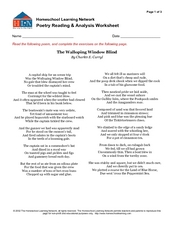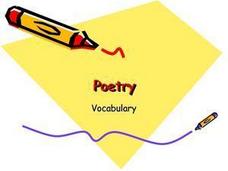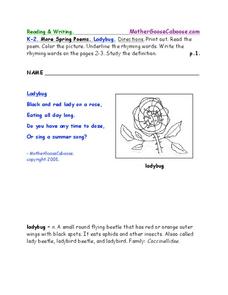National Endowment for the Humanities
Arabic Poetry: Guzzle a Ghazal!
Learners research the evolution and cultural significance of the Arabic ghazal form of poetry. They, in groups, compose an original ghazal poem and read it aloud to the class.
Macmillan Education
Understanding Poetry (Elementary)
Introduce young readers to poetry analysis with a worksheet that uses Emily Bronte's "Spellbound" to model how poets use word choice, the sounds of words, the repetition of words, and rhyming patterns to create the mood, tone, and...
Poetry4kids
Rhythm in Poetry: The Basics
What makes a great poem sound so good? Learn the rhythmic secrets of poetry with an explanatory online lesson.
National Council of Teachers of English
Writing Poetry with Rebus and Rhyme
Young scholars write rhyming poems using rebus. With pictures instead of words, authors create original work about things they love.
Winterhill School
Poetry Analysis
Gain greater insight into poems using a poetry analysis learning exercise. Here, scholars follow steps and answer questions to dissect any poem. Topics include the poem's meaning, theme, technique, and structure, as well as personal...
Poetry4kids
Rhythm in Poetry: I Am the Iamb
It's fun to write a poem with iambs! Practice using iambs in all types of different poems with an online poetry lesson.
Curated OER
Discussing Poetry In Class
Students investigate syllabic metre and rhyming techniques by analyzing poetry. In this language arts lesson, students read the poem Considering the Snail and discuss the nature and mood of the poem with their classmates. Students...
Curated OER
Poems: Identifying Patterns
Here is a great learning exercise that contains two short poems to compare and contrast. Children will read each poem out loud and then complete three comparative analysis questions which focus on rhyme, structure, and language. Note:...
Curated OER
Poetry Notes
Break this presentation into two or three days so as not to overwhelm your kids. Fifty-four slides is a lot of slides, but the PowerShow is well-organized, and terms are defined clearly and illustrated in examples provided. A general...
Curated OER
Poetry Reading: Analysis Worksheet
Explore poetry by reading the poem "The Walloping Window Blind" by Charles E. Carryl, and completing an analysis with your class. The worksheet provides the entire poem, a graphic organizer to help with summarizing and paraphrasing, and...
Poetry4kids
Rhythm in Poetry: Okie Dokie, Here’s the Trochee
Iambs and trochees may seem intimidating to some learners, but after reading a straightforward online lesson, they'll be masters of poetic feet! The lesson includes examples of trochaic poems from Edgar Allen Poe and William Blake.
Curated OER
Poetry Vocabulary
Consisting of a thorough and straightforward list of poetry terminology, the first part of this presentation would be a good introduction to a poetry unit, or a review for an upcoming poetry project. The list of terms is quite extensive,...
Curated OER
Poems: Itsy Bitsy Spider
Act out the "Itsy Bitsy Spider" rhyme with youngsters. Learners observe visual instructions before completing the corresponding actions, then draw the spider into a scene. Finally, they write down rhyming words that have the ai spelling...
Curated OER
Finding Rhyming Words in a French Poem
Explore rhyming in this phonemic awareness and French lesson. Listen to the poem "J'Adore la Pizza" by Karen Kransky and identify rhyming words. Compare grapheme spelling patterns with like phonemes, and sort word cards according to...
Curated OER
Poe's Poetry and Prosody
Motivate your class with this lesson plan! Learners use passages from Edgar Allan Poe's poetry to practice reading fluency. They read "The Raven" as a rap song to better understand the rhyming patterns and pauses.
Curated OER
Write Your Own Poem: Rhyming Word Pattern -end, -ind, -and
In this rhyming verse worksheet, students read 20 words in a chart and color them according to the directions, using a different color for each ending rhyme pattern. Students then answer 10 questions in which they write simple nonsense...
Poetry4kids
Rhythm in Poetry: More Than Two Feet
Want to put some feet in your head? Check out an online lesson about spondees, dactyls, and anapests to bring new structure to your poetic forms.
Curated OER
Rhyming Word Poems
Students create poetry. In this poetry instructional activity, students read poetry and identify rhyming words using highlighters. Students may also add rhyming lines to the poetry they read.
Curated OER
More Spring Poems: Buttercups
For this literature worksheet, students read and discuss the poem "Buttercups," color the picture, underline the rhyming words and then write the rhyming words on pages two and three several times.
Curated OER
Trees-- Rhyming Words
For this reading and writing worksheet, learners read a poem about different kinds of trees. Students practice writing the rhyming words on primary lines, color the pictures and staple these pages into a book.
Curated OER
Poetry: The Most Compact Form of Literature
Introducing or need to review literary devices and terms for a study of poetry? Though text heavy, the explanations and examples of key poetic devices will provide learners with the vocabulary they need to discuss and craft poems.
Curated OER
Ladybug Poem
For this language arts worksheet, students study rhyming patterns and learn about ladybugs by reading a short poem and coloring a picture. Students also practice printing the word "ladybug" and create a poem or story of their own.
Curated OER
Jack And Jill-- Rhyming Words Poem
In this poetry worksheet, students study rhyming words by hearing a 10 verse poem about Jack and Jill. The last word in each verse is missing, and could be supplied by students during an oral reading. Example: "Get me an apple from my...
College of the Canyons
Free Verse
Free verse poetry is often regarded as poetry without structure, but in reality, it is a poetic form that adheres to its own poet's thought and breath patterns. Delve into the rules and famous examples of free-verse poetry with a short...

























